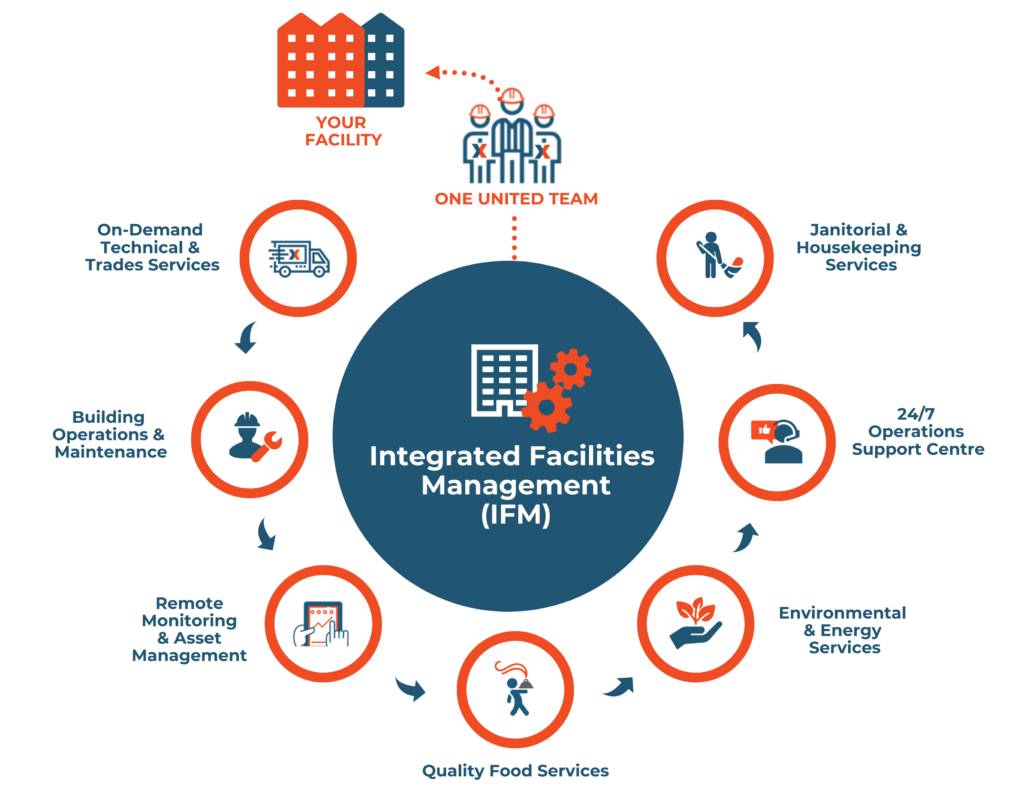Facility Management for Commercial Structures-- A Total Summary
Facility Management for Commercial Structures-- A Total Summary
Blog Article
Key Fads Shaping the Future of Facility Administration in 2024
As we look ahead to 2024, the landscape of center administration is poised for substantial transformation, driven by several vital patterns. The combination of smart building technologies and a shift in the direction of data-driven decision-making pledge to enhance functional performance while focusing on sustainability in method.
Smart Building Technologies

Smart structure modern technologies encompass a broad array of systems, including intelligent lights, cooling and heating controls, and protection systems. By integrating these systems, facility managers can keep track of and adjust specifications in real-time, causing considerable decreases in energy waste and operational costs. Wise sensors can discover occupancy degrees and change illumination and temperature accordingly, ensuring that power is just utilized when required.
Furthermore, these technologies promote boosted information collection, enabling organizations to track usage patterns and recognize opportunities for additional improvements. The implementation of clever structure innovations not only adds to sustainability goals yet additionally produces healthier job environments that can boost staff member efficiency and complete satisfaction.
As we move right into 2024, the adoption of clever building modern technologies will likely speed up, reflecting a more comprehensive change towards more intelligent, responsive, and lasting facility management techniques.
Data-Driven Choice Making
Progressively, organizations are leveraging data-driven decision making to boost facility monitoring methods. By utilizing data analytics, center managers can acquire actionable understandings that substantially enhance operational performance and resource appropriation. The integration of innovative innovations, such as IoT sensors and real-time tracking systems, makes it possible for the collection of huge quantities of data on structure performance, tenancy prices, and energy usage.
This wealth of info allows facility managers to recognize trends, anticipate maintenance demands, and proactively address concerns before they intensify. Predictive analytics can forecast tools failings, reducing downtime and repair work expenses. Furthermore, data visualization devices facilitate far better communication amongst stakeholders, making sure that informed choices are made collaboratively.
Furthermore, data-driven approaches boost critical preparation by allowing facility managers to analyze the performance of present techniques and make educated options pertaining to financial investments in innovation or facilities. As organizations progressively prioritize operational quality, data-driven decision production is poised to become a cornerstone of successful facility monitoring strategies in 2024 and past. Eventually, the capability to utilize information effectively will equip organizations to produce a lot more efficient, efficient, and resistant centers.
Sustainability and Green Practices
The focus on data-driven choice making naturally lines up with the expanding concentrate on sustainability and environment-friendly practices within center management. As organizations significantly prioritize environmental duty, facility managers are leveraging analytics to optimize resource usage, minimize waste, and lessen carbon impacts. This critical approach makes it possible for the integration of energy-efficient systems, such as LED lights, wise a/c controls, and sustainable energy resources right into facility operations.
In addition, the application of sustainable techniques prolongs beyond power usage. Facility supervisors are promoting and embracing environmentally friendly products recycling campaigns to produce a round economic climate within their centers. This not only enhances the ecological profile of the company but likewise fosters a society of sustainability among staff members.
Compliance with ecological regulations is one more crucial facet driving the adoption of environment-friendly practices. By using data analytics, facility supervisors can keep an eye on conformity metrics and recognize areas for enhancement, ensuring adherence to regional and international sustainability standards.
Crossbreed Job Models
A significant shift in the direction of hybrid work designs is improving the landscape of center management in 2024. This paradigm integrates in-office and remote work, necessitating a reevaluation of area usage, source allocation, and worker engagement strategies. Organizations are significantly recognizing the significance of versatile Discover More offices that provide to diverse needs and preferences.
Facility supervisors should adapt by implementing functional office layouts that support collective initiatives while supplying areas for focused job. This includes the assimilation of innovation to facilitate smooth interaction and partnership amongst remote and in-office workers. Smart building remedies, geared up with sensing units and analytics, enable real-time surveillance of space usage, allowing companies to informative post optimize their atmospheres successfully.
In addition, crossbreed job designs highlight the requirement for efficient facility management that focuses on employee experience. In essence, the hybrid work model is changing center administration, urging a positive strategy to satisfy the progressing needs of the workforce.
Improved Owner Wellness
As companies accept hybrid work models, a heightened concentrate on passenger health is coming to be essential to facility monitoring methods. Facility Management. This change recognizes that a healthy and completely satisfied workforce straight influences efficiency and retention rates. Facility supervisors are currently focusing on atmospheres that promote psychological and physical well-being, incorporating aspects such as all-natural lighting, biophilic design, and accessible wellness sources

Modern technology plays a crucial role in this evolution. Smart building systems can keep track of environmental variables and change setups in real-time, making certain optimal convenience levels - Facility Management. Comments mechanisms, such as occupancy sensing units and staff member studies, enable center managers to constantly improve wellness Click This Link initiatives based on passenger demands.

Conclusion
In 2024, the future of facility administration will certainly be substantially affected by the integration of smart structure technologies and data-driven decision-making, fostering improved operational efficiency. These trends collectively underscore the developing landscape of facility management in response to contemporary obstacles and possibilities.
Facility supervisors are advertising and embracing eco-friendly materials reusing initiatives to create a circular economy within their centers.A substantial shift towards hybrid job versions is improving the landscape of facility management in 2024.In addition, crossbreed work models emphasize the demand for efficient facility monitoring that focuses on worker experience.As organizations welcome hybrid job models, an enhanced emphasis on resident health is coming to be essential to facility monitoring methods.In 2024, the future of facility monitoring will be significantly affected by the combination of smart structure technologies and data-driven decision-making, cultivating enhanced operational effectiveness.
Report this page